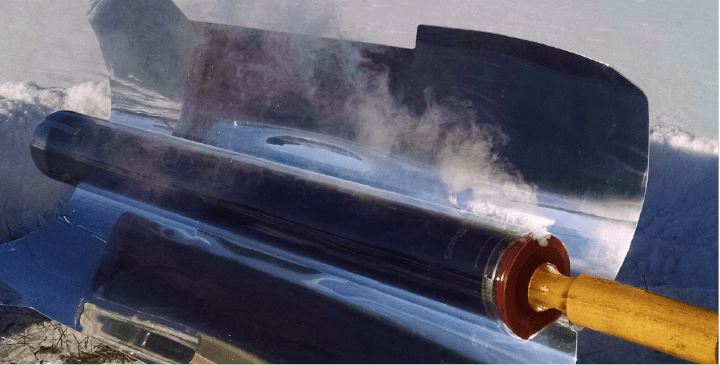A parabolic solar oven uses a reflective dish to concentrate large amount so sunlight onto a cooking vessel. This sheer amount of energy can top temperatures in excess of 250°C and allow users to cook using a frying pan as if on a stove top.
Depending on the design, a parabolic solar oven can look like a shiny satellite dish. That is because satellite dishes and parabolic cookers both apply the principle of concentrating a substance. In the parabolic solar oven's case it's sunlight; in the satellite dish's case it's digitally transmitted information that turns into a television broadcast.
This design is ideal for boiling grilling or frying on sunny days but requires periodic re-adjustment to track the Sun.
Parabolic solar ovens such as GoSun's use compound parabolic reflectors concentrate light from a variety of angles onto the cooking tube. This means that there's little need to re-adjust the stove while cooking and even diffused light (such as light going through clouds) can be focused on the tube.

Roland Winston invented the first compound parabolic concentrator (CPC) in 1974, a breakthrough technology in solar energy. His discovery has now been used extensively in solar energy collection, wireless communication, and biomedical research.
GoSun uses the principles of the parabolic solar oven to concentrate the Sun's rays to cook food, but it doesn't stop there. Gosun also uses vacuum tubes to trap in the solar heat which it collects.
The GoSun's patented solar cooking technology can bake, boil or fry a meal using nothing but energy from the sun, even in clouds, wind and freezing conditions. Heating up to 550°F/280°C while staying cool to touch, the stove's performance is only made possible from a combination of ideal materials and clever engineering.
The core of GoSun's solar cooker technology is with the vacuum tube cooking chamber, which absorbs light while acting as a perfect insulator. We think of it as a physics hack, one of thermodynamic’s only free lunches.

A perfect insulator? That’s right. Between the tube’s two layers of borosilicate glass (wiki link), is a pocket of beautiful nothing (AKA outer space). Heat requires a medium to transfer. Without a thermal bridge, the heat absorbed by the stove collects rapidly.
How is the heat absorbed? Great question! The internal face of the tube is coated in three layers of metal: aluminum nitride, stainless steel, and copper. Placed on the inside of the vacuum (away from your food), these three layers work in unison to trap both viable light and ultraviolet, allowing one to cook in a light overcast.
- Aluminum Nitride: An absorber common in the semiconductor industry with fantastic energy absorbing properties.
- Stainless Steel: Moves heat evenly, cooking food cooking from 360°.
- Copper: Reflecting heat, in the form of infrared radiation, back into the tube.

